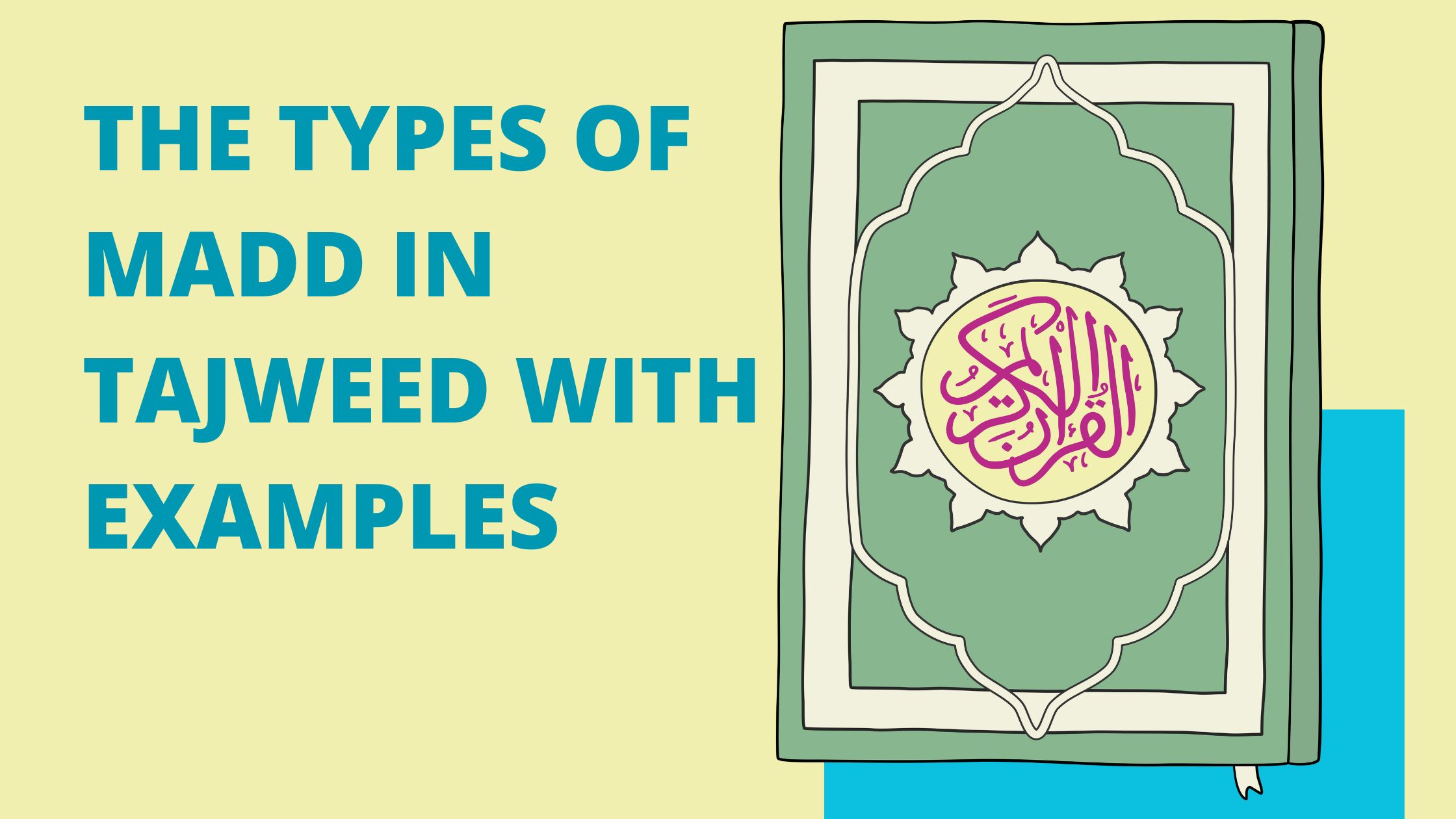In this blog post, we will explore the various types of Madd in Tajweed, uncovering their importance and providing guidance on how to perfect them.
Proper recitation of the Quran, especially through Tajweed and Madd, is essential in fully appreciating the beauty and significance of its divine words.
So, get ready to open your heart and mind as we embark on this captivating journey through the art of proper recitation!
Table of Contents
Definition of Madd
The word “Madd” means “extension” or “prolongation” and is closely linked to Tajweed rules, referring to the elongation of specific sounds when speaking certain letters.
Madd, an Arabic script, has three short vowel marks called “Harakat”. These marks, encompassing Fatha (ـَ), Damma (ـُ), and Kasra (ـِ), capture the phonetic nuances of the language.
They are accompanied by three long vowel indicators known as “Madd,” which have a significant impact on extending sounds.
Madd Letters in Arabic
The indicators are represented by three powerful letters:
1. Letter Alif (ا):
We come across the letter alif (ا) on our journey. Alif gracefully follows a consonant adorned with the fatha, appearing either as the regular alif or its counterpart, alif maqsûra (ى).
2. Letter Ya (ي):
We encounter the letter ya (ي), which appears after a consonant adorned with a kasra. In this situation, the letter ي serves as an indicator, imparting its elongating ability to the word.
3. Letter Waw (و):
We will now discuss the letter waw (و), which gracefully follows a consonant with a damma. This letter effortlessly serves as the elongating force in the Arabic language.
An Example of Madd Letters in the Quran:
The long vowel indicators in Arabic are important for phonetics and pronunciation and are present in the Quran.
The word (نُوحِيهَا) shows its influence by requiring specific conditions for each letter to be pronounced correctly.
This example highlights the significant role of long vowel indicators in shaping Arabic phonetics and pronunciation.
The significance of Madd
The word “Madd” in Arabic phonetics is very important and its combination with long vowel indicators enhances the beauty and richness of the language. It helps improve pronunciation and understanding of the language.
Bayanulquran Academy offers online Tajweed classes that provide a convenient and effective method for learning and mastering various types of madd. For more information and to enroll in their classes, please visit our website or contact us directly.
Types of Madd in Tajweed with Easy Examples
Madd is an important concept in Tajweed that involves prolonging sounds. There are 13 types of Madd, classified into two categories with subcategories each:
1. Natural Prolongation (Madd Asli)
Natural Prolongation, or “Madd Asli,” is the first category which showcases the ethereal beauty of extended and enlivened sounds through four subcategories.
2. Secondary Prolongation (Madd Far’ee)
Secondary Prolongation, also known as “Madd Far’ee,” is a category in the study of Arabic phonetics that involves the presence of hamza or Sukoon and offers six subcategories with unique perspectives on elongating sounds.
1. Normal Madd (Madd Asli)
Normal Madd (Madd Asli) is a type of elongation in Tajweed that occurs independently and consistently spans two counts.
It is natural and distinct from the deliberate elongation caused by hamza or Sukoon. Proper understanding and application of these rules can enhance the recitation of the Quran.
A. Natural Madd (Madd Tabi’y)
Madd Tabi’y is a simple and elegant elongation in the Arabic language characterized by long vowels without hamza or sukoon, lasting for two counts.
The letters Alif, Waw, and Ya are essential to this elongation and it occurs in three situations: when a consonant with fatha precedes Alif, kasra precedes Ya, or damma precedes Waw.
| Example of Natural Madd (Madd Tabi’y) | Natural Madd is exemplified in the beautiful verses of the Quran, specifically through the use of the word “قَاْل. |
B. Madd Ewadd (Compensation Madd)
Madd Ewadd is a special type of elongation in Tajweed that appears at the end of words with tanween fat-h.
It is achieved by pronouncing the tanween as an elongated alif for two counts to compensate for its presence.
The conditions for Madd Ewadd
1. Madd Ewadd is a rule in the recitation of the Quran that involves elongating the letter alif at the end of a word that concludes with tanween fat-h, but only if there is a pause after the word.
2. If there is no pause, the tanween fat-h must be pronounced and Madd Ewadd does not apply.
| Example of Madd Ewadd | Madd Ewadd can be seen in the word ثوابًا, where pausing after the word results in it being pronounced as ثوابا. |
C. Madd Al- Badal (Substitute Madd)
Madd Al-Badal, or Substitute Madd, is a melodic technique found in Arabic recitation where a hamza is replaced by a harf madd (ا, ي, or و).
This substitution follows specific rules and occurs when a hamza is accompanied by the corresponding diacritic.
| Example of Madd Al-Badal | The concept of Madd Al-Badal, present in Quranic verses, is exemplified by the word أوتوا, where the hamzah and waw are harmonized for two counts. |
D. Madd As-Silah Al-Sughra (Minor connecting Madd)
Madd as-silah sughra is a linguistic phenomenon in Arabic where the letter Ha at the end of words is pronounced quickly when it follows certain letters or vowel marks.
The requirements of Madd as-silah sughra
Madd as-silah sughra has specific requirements that must be followed, including:
1. Continuing to the next word without pausing and making sure that the Ha is pronounced as a separate pronoun between two vowels.
2. It cannot be followed by a hamzah and if it has a dammah or kasra.
3. It is lengthened for two counts before moving on.
| Example of Madd As-Silah Al-Sughra | The letter Ha at the end of the word “مِنْ” in the verse “إِنَّهُ مِنْ” is pronounced quickly and represents a third-person singular pronoun. It also has a lengthened dammah before transitioning to the next word. |
1.5. Madd Al-Tamkeen (Stabilizing Elongation)
Madd Al-Tamkeen, also known as Stabilizing Elongation refers to when two successive instances of the same letter, yâ or waw, occur with one acting as a prolongation marker. This requires a specific articulation to elongate the letter over two beats, known as harakatayn.
Madd Al-Tamkeen is the elongation of certain letters in Quranic recitation to prevent assimilation (Idgham) and emphasize the unique sounds and meanings of each word.
| Example of Madd Al-Tamkeen | The Quranic verse “Hu-yit-tum” showcases the principle of Madd Al-Tamkeen through the repetition of the yâ letter and its elongation on two consecutive occasions. |
2. Secondary Madd (Madd Far’ee)
Secondary Madd, also known as Madd Far’ee, is a linguistic technique that uses vowel elongation with the presence of either Hamza or Sukoon.
Madd Far’ee can be seen in two distinct forms.:
1. Madd Far’ee due to Hamza
2. Madd Far’ee due to Sukoon.
| Examples of Madd Far’ee | Examples of Madd Far’ee within the sacred verses of the Quran:1. (إلا أن يشاء الله) – “Unless Allah wills” – The elongation is achieved through the interplay of Hamza, creating an ambiance that draws the listener closer to the divine.2. (ربّ اجعل لي ءاية) – “O Lord, make for me a sign” – These words contain a Madd Far’ee that is achieved through Sukoon, resulting in a profound transformation that enhances the verse. |
A. Madd Wajeb Muttasil (Obligatory Connecting Madd)
Madd Wajeb Muttasil, also known as Obligatory Connecting Madd, is a specific prolongation that occurs in Quran recitation when a hamzah follows a harf madd.
Madd Wajeb Muttasil can be extended for four or five counts and must remain consistent throughout the recitation.
| Examples of Madd Wajeb Muttasil: | Madd Wajeb Muttasil can be seen in Quranic verses like “السمآء” (Al-Samaa’), where the hamzah is pronounced after the letter ا, causing a mandatory prolongation. |
B. Madd Ja’ez Munfasil (Permissible separate Madd)
Madd Ja’ez Munfasil applies when a word ends with a madd letter and is followed by a word beginning with a hamza letter. The madd sound should be prolonged over two words, but it is not obligatory to do so.
Madd Ja’ez Munfasil allows the madd sound to be prolonged over two words, specifically when a word ends with a madd letter and is followed by a word starting with a hamza letter.
This rule implies that the pause between the two words should be pronounced with the madd sound, but it is not required to do so.
| Example of Madd Ja’ez Munfasil | The Madd Ja’ez Munfasil rule in Quranic verses is demonstrated in the phrase “بمآ أنزل” where the madd sound can be extended over two words, with a pause between them pronounced as part of the madd. |
C. Madd As-Silah Al-Kubra (Major Connecting Madd)
The Madd as-silah al-Kubra is a unique aspect of Arabic pronunciation that involves elongating the sound when the masculine pronoun (هُ) is followed by the letter hamza (ء).
There is flexibility in how long this elongation should be, but traditional preferences tend to favor a four-count elongation.
This practice reflects the importance of upholding historical authenticity and melodic precision in Qur’anic recitation.
| Example of Madd As-Silah Al-Kubra | To illustrate the application of Madd as-silah al-Kubra, let’s consider a verse from the Quran: مَالَهُ أَخْلَدَهُ. In this verse, the elongation occurs due to the combination of the masculine pronoun “هُ” followed by the letter “ء.” |
D. Madd Lazem (Compulsory Madd)
Compulsory Madd, also known as Madd Lazem, refers to the elongation of a letter of prolongation within a single word when followed by an obligatory sukoon.
There are two types of Madd Lazem, namely kalimi (within a word) and harfi (within a letter). Each type can further be classified as heavy Madd and light Madd. The length of each type is measured by 6 counts.
| Example of Madd Lazem | To better understand Madd Lazem, let’s consider the following Quranic verse, “الضَّالِّينَ” (Ad-Daalleen).The verse demonstrates compulsory elongation in the letter “ل” with an obligatory sukoon, following the rules of Madd Lazem. |
E. Madd ‘Ared Li- Sukoon (Madd Exposed to Sukoon)
Madd ‘Ared Li-Sukoon is when the second-to-last letter in a word is a madd, and the last letter becomes silent when the reciter pauses for reflection.
The rules for Madd ‘Ared Li-Sukoon include placing the elongation letter in the second-to-last position without any diacritics and using a suitable diacritic on the preceding letter for proper pronunciation and smooth recitation.
When reciting a word with Madd ‘Ared Li-Sukoon, the reciter can either stop and stretch the sound for 2, 4, or 6 counts or connect it to the next word with a 2-count stretch.
| Examples of Madd ‘Ared Li- Sukoon in Quranic Verses | An example of Madd ‘Ared Li-Sukoon can be found in the Quranic verses: (الرحمَٰنْ) The second-to-last letter “م” is the harf madd and the final letter “ن” is moving. When pausing, the last letter can become sakin and the reciter may extend its sound for 2 counts. |
F. Madd Al-Leen (Madd of Easiness)
Madd Al-Leen, also known as “The Soft Elongation,” is a captivating aspect of Quranic recitation that adds elegance and fluidity to the Arabic language.
It occurs when a reader gracefully pauses on a word, allowing the second-to-last letter to be either “و” (waw) or “ي” (ya), with a sukoon, following a letter with a fatha.
Types of duration in Madd Al-Leen:
Behold, there are three categories of duration in Madd Al-Leen, each offering its own unique essence:
1. Brief Recitation:
This swift reading delicately extends the sound by embracing two beats, leaving a lasting impression on the listener’s ear.
2. Moderate Recitation:
For a balanced, medium-paced reading, the elongation stretches to four beats, adding a gentle and melodic flourish to the words.
3. Deliberate Recitation:
When verses are read slowly and thoughtfully, rich with contemplation, the elongation unwinds over six beats.
| Example of Madd Al-Leen in Quranic Verses | To illustrate the concept, let us examine an example of Madd Al-Leen found in Quranic verses: (لِإِيلَافِ قُرَيْشٍ)The verse from Surah Al-Fiil in the Quran demonstrates Madd Al-Leen. It features the elongation in the word “قُرَيْشٍ,” where the ya (ي) is the second-to-last letter with a sukoon, preceded by the letter ra with a fatha. |
Elevate Your Connection with the Quran through Bayanulquran’s Online Tajweed Courses
Elevate Your Connection with the Quran through Bayanulquran Academy’s Online Tajweed Courses. Whether you are a beginner or an advanced learner, our comprehensive online courses will guide you in understanding and implementing the art of proper recitation.
With expert instructors and interactive lessons, you’ll gain a deep understanding of the different types of Madd in Tajweed. Through our engaging curriculum, you’ll not only enhance your mastery of Tajweed rules but also develop a profound connection with the Quran.
Join Bayanulquran today and embark on a transformative journey towards connecting with the divine words of Allah (SWT).
FAQs
What is the importance of learning about the different types of Madd in Tajweed?
Learning about the different types of Madd in Tajweed is crucial for proper Quranic recitation. Understanding these rules allows for accurate, clear, and beautiful recitation, enhancing the connection with the words of Allah.
How can I improve my Tajweed skills?
Improving Tajweed skills requires practice, patience, and guidance from qualified teachers. Bayanulquran offers online Tajweed courses at various levels, providing comprehensive lessons, exercises, and personalized feedback.
Can I learn Tajweed online?
Yes, online platforms like Bayanulquran offer comprehensive Tajweed courses catered to students of all levels, allowing for self-paced learning with qualified teachers.
Do I need prior knowledge or experience before enrolling in a Tajweed course?
No, Tajweed courses at Bayanulquran accommodate learners of all levels, whether starting from scratch or having some basic understanding already.
Are there any age restrictions for learning Tajweed?
No, there are no age restrictions for learning Tajweed. Bayanulquran offers classes for both children and adults, ensuring everyone can embark on their journey towards mastering Quranic recitation.
How long does it take to master Tajweed?
The time required to master Tajweed varies based on individual effort, dedication, and prior knowledge. It may take several months or years to become proficient in all aspects of Tajweed.
Conclusion
Mastering the art of proper recitation in Tajweed is a dedicated journey that requires practice. The different types of Madd in Tajweed, such as Normal Madd and Secondary Madd, are essential for achieving clarity, beauty, and precision when reciting the Quran.
By studying and perfecting these forms of elongation, we can strengthen our connection with Allah’s divine words.
Bayanulquran offers online Tajweed courses, providing an excellent opportunity to learn and improve under expert guidance. Start your enriching journey today!

















